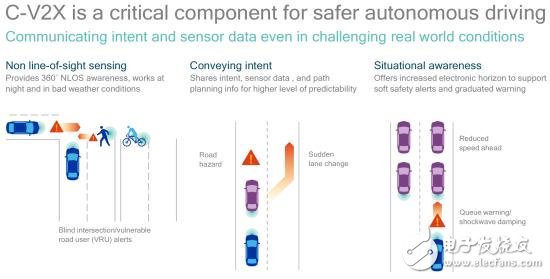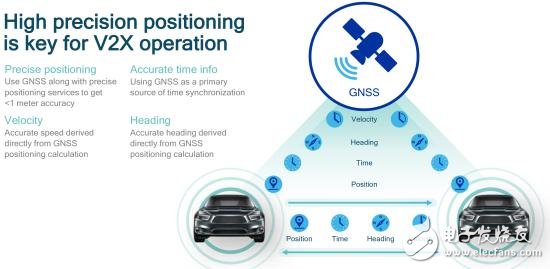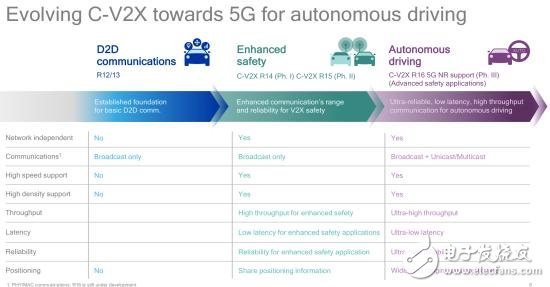Qualcomm and automakers push C-V2X commercial PSA and Qualcomm to announce progress in C-V2X testing
Qualcomm is working with ecosystems of leading automakers and automotive suppliers to accelerate the commercial adoption of cellular vehicle networking (C-V2X) technology with the Qualcomm® 9150 C-V2X chipset solution. The C-V2X is a global solution for V2X communications designed to support automotive safety, automated driving and increased traffic efficiency. Tier 1 suppliers, cellular module manufacturers, software solution providers and system integrators have all said they support the deployment of C-V2X technology in upcoming mass production vehicles and roadside units (RSUs) starting in 2019. Qualcomm Technologies is currently working with automotive manufacturers and automotive ecosystem members in Germany, France, Korea, China, Japan and the United States to conduct C-V2X field validation.
"The continued evolution of cellular technology to 5G is an essential part of a networked collaborative autonomous vehicle that will support the future vision of the BMW Group, as our city and life change," said Maik Böres, head of the BMW Group's future travel team. More interconnected, direct communication and network-based communications C-V2X is a natural solution to a growing range of security and informational use cases. Qualcomm Technologies today announced that the automotive industry is accelerating the commercial use of C-V2X technology, especially It is expected that significant progress will be made in integrating C-V2X technology into vehicles in 2019."
Those interested in adopting Qualcomm Technologies solutions to include C-V2X technology in next-generation automotive ecosystems include Tier 1 suppliers LG Electronics, Continental, Ficosa-Panasonic, Lear and Valeo, and cellular module manufacturer Gemalto. LG Innotek, Mobile Communications, Sierra Wireless, Telit, Kaishun Technology and ZTE. Qualcomm Technologies also collaborates with V2X software stack and application providers Cohda Wireless, Commsignia and Savari, as well as system integrators Sasken and Zhongke Chuangda to accelerate C-V2X commercialization, helping the automotive ecosystem to take full advantage of the entire industry for over a decade in intelligent transportation. Investment in system (ITS) software and standardized protocols such as ETSI-ITS, IEEE WAVE and SAE.
The C-V2X is globally compatible with 5G and complements other advanced driver assistance system (ADAS) sensors such as cameras, radar and lidar. The C-V2X direct communication mode is designed to provide low-latency communication for car-to-vehicle (V2V), vehicle-to-the-road infrastructure (V2I) and vehicle-to-travel (V2P) for cars, through a specific, uniform 5.9 GHz The ITS spectrum operates without the need to use a cellular network or become a cellular network user. The C-V2X is currently being tested globally and continues to be supported by the global automotive industry and the wider transportation ecosystem. The 5G Auto Alliance (5GAA), an industry organization that supports the development of C-V2X, currently has more than 70 members, including automakers, Tier 1 suppliers, mobile operators, semiconductor companies, test equipment vendors, telecommunications providers, and transportation. Signal providers and road operators.
Automakers planning to integrate V2X solutions will also benefit from the cost-effectiveness of C-V2X. According to analysis by technology consultancy P3 North America, the fully integrated system that integrates C-V2X into existing LTE telematics units is the most cost-effective solution for all V2X deployments.
The 9150 C-V2X chipset solution extends direct communication range, increases reliability and reduces latency in crowded road environments. Following the clear direction of the evolution of 3GPP specifications to 5G New Air Port (5G NR), Qualcomm Technologies will continue to invest in the development of the C-V2X product roadmap to provide new and complementary features. To meet the automotive manufacturer's production needs, the 9150 C-V2X chipset solution is scheduled to be commercially available in the second half of 2018, and some vendors are expected to launch a 9150 C-V2X chipset-based solution.
Nakul Duggal, vice president of product management at Qualcomm Technologies, Inc., said: "By providing superior performance and strong synergies with in-vehicle information processing systems, the C-V2X significantly enhances road safety and supports future autonomous driving compared to previous technologies. Automotive. It also complements Qualcomm Technologies' other automotive solutions, including high-precision Global Navigation Satellite System (GNSS) positioning, computer vision, computing and machine learning platforms, and sensor integration. We are excited to work with automakers and The ecosystem of leading automotive suppliers is collaborating to accelerate the commercial use of C-V2X direct communication, and the 9150 C-V2X chipset solution will be used in automobiles as early as next year."
PSA and Qualcomm Announce Progress in C-V2X Technology Testing
According to foreign media reports, PSA Group and Qualcomm Technology Co., Ltd. announced that they have made progress in testing C-V2X communication technology.

Since the announcement of the test in February 2017, PSA and Qualcomm Technologies have been conducting C-V2X technology testing. One of the purposes of this test is to verify that C-V2X technology is the first step in deploying 5G network technology in automobiles to achieve direct communication between vehicles.


PSA and Qualcomm will showcase the technology for the first time in March at the In&Out Digital Mobility in Rennes, France. At that time, the above two will be equipped with C-V2X technology in the PSA car, and use the Qualcomm 9150 C-V2X chipset and reference platform. Specific use-cases will show how C-V2X technology can support advanced driver assistance functions, how vehicles can communicate seamlessly with other vehicles, alert other vehicles to potential road hazards or poor driving conditions, such as slow traffic flow. Or the vehicle is banned.
The evolution of C-V2X will combine 5G NR function, which has the characteristics of high data throughput, ultra-low latency and high reliability, and can provide broadband carrier communication technology support for autopilot advanced use cases. Autopilot advanced use cases include: high data throughput sensors, intent sharing, and 3D HD map updates.
To further support the global expansion of the C-V2X ecosystem, PSA Group recently joined the 5G AutomoTIve AssociaTIon (5GAA). 5GAA supports the development of C-V2X direct and network communications. The alliance has absorbed more than 70 global companies, including automakers, mobile operators, semiconductor companies, test equipment suppliers, telecommunications network providers and intelligent transportation equipment. And software vendors, etc.
Qualcomm has been working on the development of the V2X ecosystem for many years. It originally developed IEEE 802.11p-based products, including the QCA6584AU. The currently developed products include the Qualcomm C-V2X 9150 chipset.
Strobe Light,Strobe Lights For Car,Amber Strobe Lights,Emergency Strobe Lights
NINGBO SANCO ELECTRONICS CO., LTD. , https://www.sancobuzzer.com